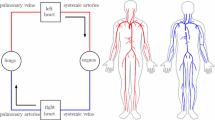Abstract
A mathematical model of pulsatile flow in cat lung based on existing morphometric and elastic data is presented and validated by experimental results. In the model, the pulmonary arteries and veins were treated as elastic tubes, whereas the pulmonary capillaries were treated as two-dimensional sheets. The macro- and microcirculatory vasculature was transformed into an analog electrical circuit. Input impedances of the pulmonary blood vessels of every order were calculated under normal physiological conditions. Pressure-flow relation of the whole lung was predicted theoretically. Experiments on isolated perfused cat lungs were carried out. The relation between pulsatile blood pressure and blood flow was measured. Comparison of the theoretically predicted input impedance spectra with those of the experimental results showed that the modulus spectra were well predicted, but significant differences existed in the phase angle spectra between the theoretical predictions and the experimental results. This latter discrepancy cannot be explained at present and needs to be further investigated. © 1998 Biomedical Engineering Society.
PAC98: 8745Hw, 8710+e
Similar content being viewed by others
REFERENCES
Fung, Y. C., and S. S. Sobin. Theory of sheet flow in lung alveoli. J. Appl. Physiol.26:472-488, 1969.
Fung, Y. C. Theoretical pulmonary microvascular impedance. Ann. Biomed. Eng.1:221-245, 1972.
Fung, Y. C. Fluid in the interstitial space of the pulmonary alveolar sheet. Microvasc. Res.7:89-113, 1974.
Fung, Y. C., and R. T. Yen. A new theory of pulmonary blood flow in zone 2 condition. J. Appl. Physiol.60(5):1638- 1650, 1986.
Fung, Y. C., Biomechanics: Circulation, 2nd ed. New York: Springer-Verlag, 1996, pp. 108–205.
Gan, R. Z., Y. Tian, R. T. Yen, and G. Kassab. Morphometry of the dog pulmonary venous tree. J. Appl. Physiol.75:432- 440, 1993.
Gan, R. Z., and R. T. Yen. Vascular impedance analysis in dog lung with detailed morphometric and elasticity data. J. Appl. Physiol.77(2):706-717, 1994.
Grant, B. J. B., and L. J. Paradowski. Characterization of pulmonary arterial input impedance with lumped parameter models. Am. J. Physiol.252:H585-593, 1987.
Horsfield, K. Functional morphology of the pulmonary vasculature. In: Respiratory Physiology, edited by H. K. Chang and M. Paiva. New York: Marcel Dekker, 1989, pp. 499- 531.
Huang, W., R. T. Yen, M. McLaurine, and G. Bledsoe. Morphometry of the human pulmonary vasculature. J. Appl. Physiol.81(5):2123-2133, 1996.
Jiang, Z. L., G. S. Kassab, and Y. C. Fung. Diameter-Defined Strahler system and connectivity matrix of the pulmonary arterial tree. J. Appl. Physiol.76(2):882-892, 1994.
Kassab, G. S., C. A. Rider, N. J. Tang, and Y. C. Fung. Morphometry of pig coronary arterial trees. Am. J. Physiol.265:H350-356, 1993.
Li, J. K-J., J. Melbin, and A. Noordergraaf. Pulse wave propagation. Circ. Res.49:442-452, 1981.
Lilagan, P. E., B. E. Marshall, and A. Noordergraaf. Analysis of deficiencies in models of the pulmonary circulation using the two-port method. Adv. Bioeng. ASME26:507-510, 1993.
Ling, S. C., H. B. Atabek, W. G. Letzing, and D. J. Patel. Nonlinear analysis of aortic flow in living dogs. Circ. Res.33:198-212, 1973.
Lucas, C. L., B. Ha, G. W. Henry, J. L. Ferreiro, and B. R. Wilcox. Toward a minimal lumped parameter model of the pulmonary input impedance spectrum. Adv. Bioeng. ASME26:503-506, 1993.
Milnor, M. R. Hemodynamics, 2nd ed. Baltimore: Williams & Wikins, 1989.
Olman, M. A., R. Z. Gan, R. T. Yen, I. Villespin, R. Maxwell, C. Pedersen, R. Konopka, J. Debes, and K. M. Moser. Effect of chronic thromboembolism on the pulmonary artery pressure-flow relationship in dogs. J. Appl. Physiol.76(2):875-881, 1994.
Sobin, S. S., Y. C. Fung, H. M. Tremer, and T. H. Rosenquist. Elasticity of pulmonary alveolar microvascular sheet in the cat. Circ. Res.30:440-450, 1972.
Sobin, S. S., R. G. Lindal, Y. C. Fung, and H. M. Tremer. Elasticity of the smallest noncapillary pulmonary blood vessels in the cat. Microvasc. Res.15:57-68, 1978.
Sobin, S. S., Y. C. Fung, R. G. Lindal, H. M. Tremer, and L. Clark. Topology of pulmonary arterioles, capillaries, and venules in the cat. Microvasc. Res.19:217-233, 1980.
Tian, Y., and R. T. Yen. Model studies of vascular impedance of cat's lung with detailed anatomical and elasticity data (abstract). Adv. Bioeng. ASME22:447-450, 1992.
Weibel, E. R. Morphometry of the Human Lung. New York: Academic, 1963.
Wiener, F. E., E. Morkin, R. Skalak, and A. P. Fishman. Wave propagation in the pulmonary circulation. Circ. Res.19:834-850, 1966.
Womersley, J. R. Oscillatory flow in arteries: The constrained elastic tube as a model of arterial flow and pulse transmission. Phys. Med. Biol.2:176-187, 1957.
Yen, R. T. Elastic properties of pulmonary blood vessels. In: Respiratory Physiology: An Analytical Approach, edited by H. K. Chang and M. Paiva. New York: Marcel Dekker, 1990, pp. 533–559.
Yen, R. T., and Y. C. Fung. Model experiment on apparent blood viscosity and hematocrit in pulmonary alveoli. J. Appl. Physiol.35:510-517, 1973.
Yen, R. T., Y. C. Fung, and N. Bingham. Elasticity of small pulmonary arteries in the cat. J. Biomech. Eng.102:170-177, 1980.
Yen, R. T., and L. Foppiano. Elasticity of small pulmonary veins in the cat. J. Biomech. Eng.103:38-42, 1981.
Yen, R. T., F. Y. Zhuang, Y. C. Fung, H. H. Ho, H. Tremer, and S. S. Sobin. Morphometry of cat pulmonary venous tree. J. Appl. Physiol.55:236-242, 1983.
Yen, R. T., F. Y. Zhuang, Y. C. Fung, H. H. Ho, H. Tremer, and S. S. Sobin. Morphometry of cat's pulmonary arterial tree. J. Biomech. Eng.106:131-136, 1984.
Yen, R. T., Y. C. Fung, F. Y. Zhuang, and Y. J. Zeng. Comparison of theory and experiments of blood flow in cat's lung. In: Biomechanics in China, Japan, and USA, edited by Y. C. Fung, E. Fukada, and J. J. Wang. Beijing: Science Press, 1984, pp. 240-243.
Zhuang, F. Y., Y. C. Fung, and R. T. Yen. Analysis of blood flow in cat's lung with detailed anatomical and elasticity data. J. Appl. Physiol.55:1341-1348, 1983.
Rights and permissions
About this article
Cite this article
Huang, W., Tian, Y., Gao, J. et al. Comparison of Theory and Experiment in Pulsatile Flow in Cat Lung. Annals of Biomedical Engineering 26, 812–820 (1998). https://doi.org/10.1114/1.107
Issue Date:
DOI: https://doi.org/10.1114/1.107




